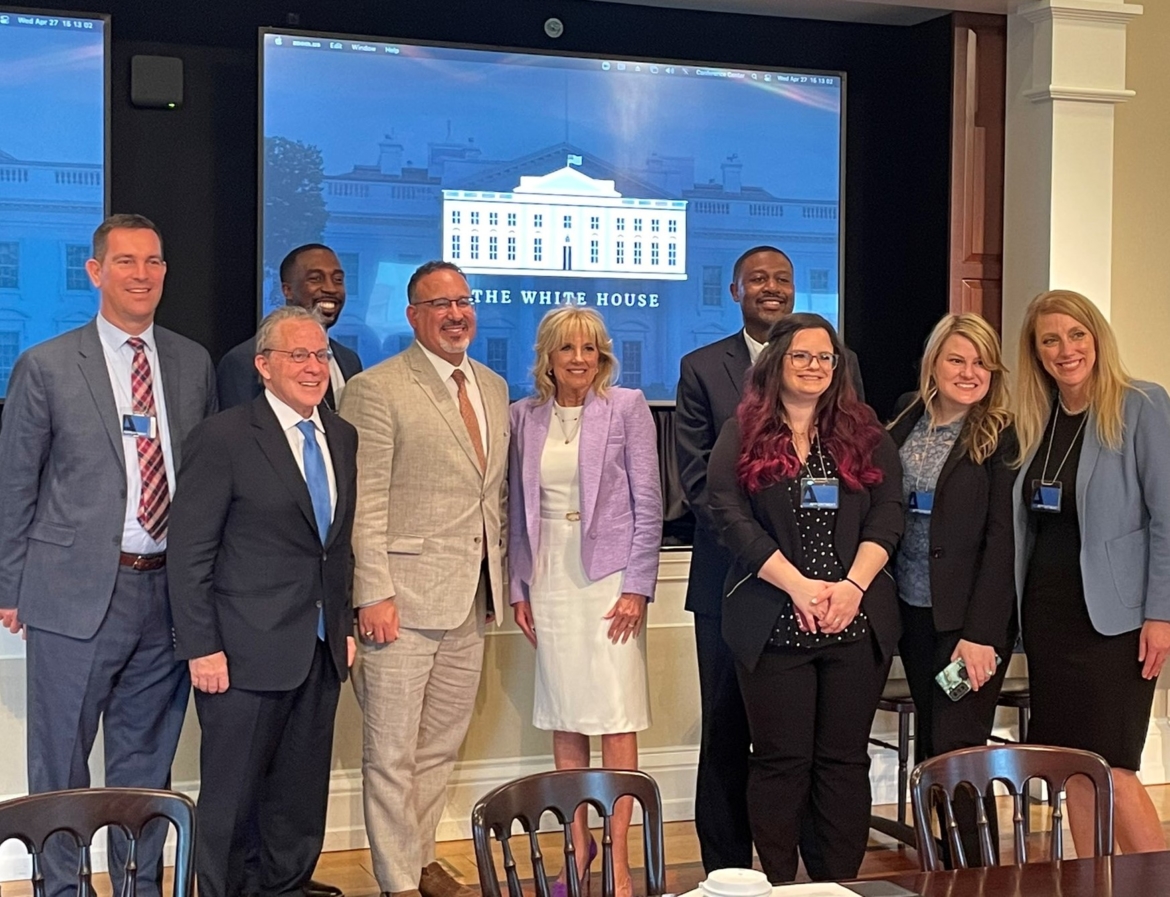When an Elementary School Principal Goes to the White House
Here’s how one principal used his seat at the table with the Secretary of Education and First Lady to share how his school needed—and put to good use—American Rescue Plan funds.

In March 2021, President Joe Biden signed the American Rescue Plan (ARP) into law, which provided $122 billion in direct funding for K-12 schools. The passage of ARP funding followed previous infusions of federal funding—$190 billion combined—to help schools respond to and recover from the pandemic. Over the past two years, the funds have helped schools implement layered COVID-19 prevention strategies to keep schools open safely, address academic needs, and bolster student mental health supports. Last week, NAESP member Edward Cosentino, principal of Clemens Crossing Elementary School in Columbia, Maryland, was invited to the White House to meet with U.S. Secretary of Education Miguel Cardona and First Lady Jill Biden to discuss how ARP funds have been deployed in his district and how they are helping students and staff.
A Seat at the Table
Making sure the principal’s voice is captured in education policies is imperative to meet the growing needs of school communities and the principal profession. This means having a seat at the table in these discussions. I was fortunate to represent NAESP and elementary school principals as one of six educators—three teachers and three principals—invited to the White House to have a candid conversation with U.S. Secretary of Education Miguel Cardona and First Lady Jill Biden. The main purpose of our meeting was to share the impact of the COVID-19 pandemic on schools and how ARP helped open schools and keep them open over the past year. Together, we told firsthand accounts of successes and challenges over the past two years, reflecting mostly on the past year when over 99 percent of the schools nationwide had reopened—a monumental task that could not have been done without the influx of funds from the ARP.
What’s my school’s pandemic story? It’s one of community and resilience and doing whatever it took to support our students, faculty and staff, and school families. Our school community had heart, dedication, and compassion, but we needed more: We faced challenges that only funding could fix. In my district and at my school, ARP funds made an incredible impact.
Using Funding to Keep Schools Safe
So much happened this school year. We often forget that elementary-aged students were not vaccinated when we opened our school in August 2021, and they were not eligible for a vaccine until November that year. This meant that we had to manage school reopening without vaccinated children. This was a huge lift.
We used ARP funds in many ways to help keep students and staff safe so students could learn. We made sure we had as much personal perfective equipment as possible. Everyone was required to wear a mask in school until March 2022. Reusable cloth masks, KN95, and disposable surgical masks were provided to students, staff, and visitors. We provided hand sanitizer stations in high-traffic areas around the school building, along with hand sanitizer pump bottles in each classroom. Hand wipes were provided in every room, and they were used to clean hands and hard surfaces.
Lunchtime was a logistical challenge in my building. We installed plexiglass dividers on lunch tables to keep children safe when they ate with their masks off. We also created an outdoor eating space with folding chairs and tables under a tent on our playground area. Our district also focused on better air filtration and purchased portable HEPA filters for each classroom in addition to upgraded MERV-13 filters in our HVAC systems.
All of these precautionary purchases cost money that our district didn’t have readily available, but we were able to use ARP funds to pay for them and ensure our learning environment was as safe as possible.
Prioritizing Mental Health and Equity
Safety was paramount in our district. With that taken care of, we shifted our focus to equitable student learning and student and staff well-being as the pandemic led to a mental health crisis in schools nationwide. Our district was able to provide Chromebooks for each student. Two grade levels did not have devices at the start of this year due to supply chain shortages. We were able to offer more seats at summer school, and we established before-school tutoring to help students fill in any gaps that might have developed.
On top of the environmental, safety, and learning challenges that were addressed and supported by ARP funds, the entire panel at the White House that day expressed uniform concerns about student well-being. The COVID pandemic clearly elevated mental health concerns from the elementary school level all the way to the high school level. The teachers on the panel see the challenges and mental health concerns in their classrooms on a daily basis. The principals also shared stories about mental health challenges in their schools and acknowledge that the pandemic made those challenges worse.
Sharing Our Stories With Policymakers
As I reflected on my period of time listening to stories from across the country and sharing stories of my own, I was in awe that I had this opportunity. I felt Secretary Cardona and the First Lady listened to our stories and asked insightful questions that furthered our discussions. It is evident that this administration prioritizes education and wants to provide schools with what is needed to thrive. This is how government should work. Elected and appointed officials should spend time listening to people, and this is what took place during my visit. We actually were scheduled to meet only with the Secretary Cardona. When the First Lady showed up, it was an incredible surprise. She was personable and gracious and showed that she understood as she shared her own experiences as a teacher. Her involvement showed that she truly cared about the well-being of our students and wanted to empower the Secretary Cardona to advocate for the needs of our students, schools, and districts.
Secretary Cardona shared that he was scheduled to testify in Congress the following day to support the president’s budget, which is proposed to increase educational funding to historic levels. He spoke about his post-pandemic vision and the unique opportunity we’ve been given to reimagine education. What are the lessons learned from the past two years? Where can the federal government provide greater support? My experience that day was enlightening, and I left the White House grounds very hopeful for the future on the other side of the pandemic. I was inspired that we have an educator as a First Lady, and a former elementary school teacher and principal as the Secretary of Education.
Edward Cosentino is principal of Clemens Crossing Elementary in Columbia, Maryland.




